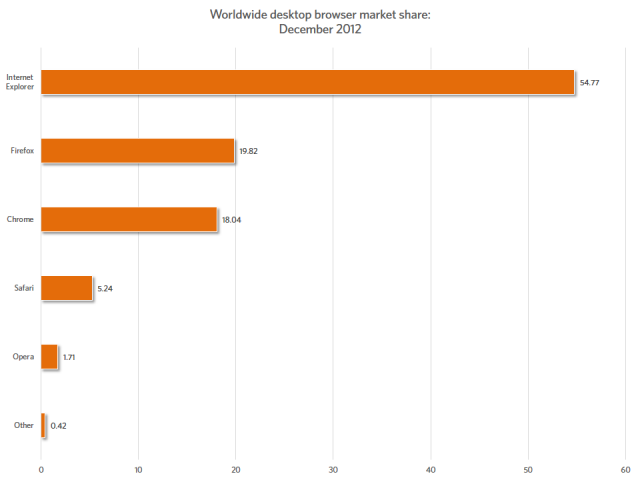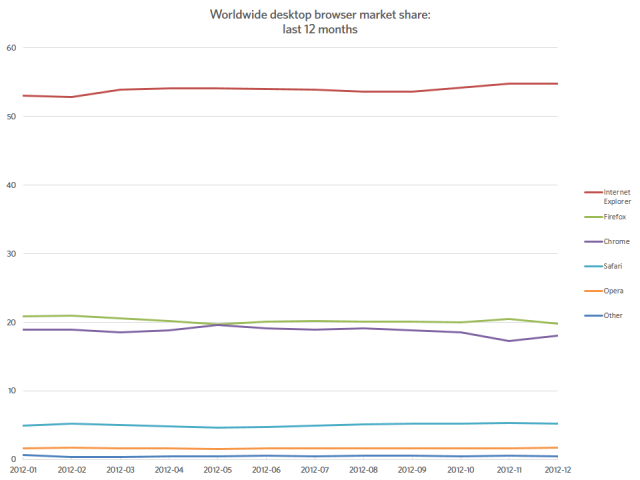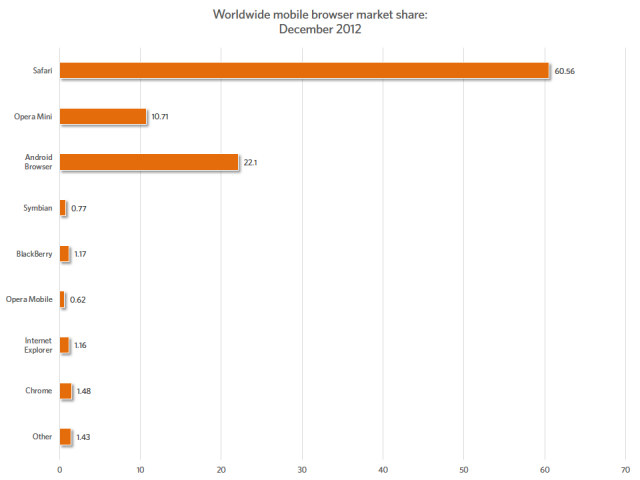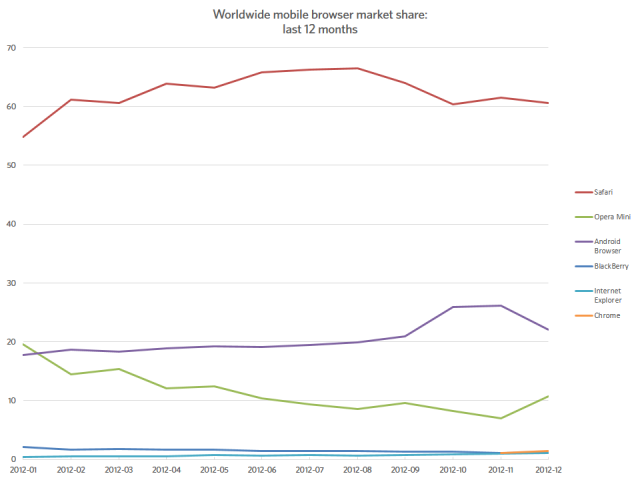
Internet Explorer finished 2012 with its highest market share since August 2011. In spite of a few close calls, Firefox maintained its lead over Chrome, holding on to second place for the full year.
Microsoft's browser was virtually unchanged, up 0.01 points at 54.77 percent. Firefox was down 0.62 points at 19.82 percent, dropping below 20 percent for the second time in three months. Chrome was up 0.8 points to 18.04 percent, its first gain since August. Of the also-rans, Safari was down slightly, dropping 0.09 points to 5.24 percent, and Opera was up 0.04 points to 1.71 percent.
Chrome suffered setbacks in early 2012, with Google penalizing its own browser for a promotional campaign that broke the search engine's marketing rules, and accordingly saw Chrome's online presence plummet in Google's rankings. Mozilla, meanwhile, started hitting its stride with its rapid release schedule for Firefox: over the last year, the browser has gained both an automatic, mostly transparent updater (similar to Chrome's), and a series of enterprise-friendly releases that promise to provide long-term security updates (though "long-term" in this rapid release world translates only to about 30 weeks).
Microsoft's position has been buoyed by the continued strong uptake of Windows 7, and with it, Internet Explorer 9.
In the mobile market, Android's position has continued to strengthen over the course of the year, but Apple's iOS devices remain more widely represented on the Web. December presented a rare highlight for Microsoft on the mobile Web, too; for the first time in more than two years, Internet Explorer took more than 1 percent of the mobile browsing market. Redmond's browser remains a tiny player overall, but a larger share of a larger market may be a small sign that Windows Phone is starting to see a little success.
Chrome and Firefox are settling into their now established updated patterns. Both browsers see a majority of their users make the switch to each new version automatically, but a minority of users are getting stuck on an older, unsupported version of the browser, and subsequently taking a long time to upgrade. About 1.8 percent of Web users are on a version of Chrome that's at least two versions out of date (that's about 10 percent of all Chrome users), and 5 percent of Web users are on an obsolete, unpatched version of Firefox—fully a quarter of all Firefox users.

The end of the year was more mixed for Microsoft. There are some things that the company will be pleased about. Its overall share of the browser market grew, with Internet Explorer 9 almost doubling its usage, and the ancient Internet Explorer 6 losing about a quarter of its users over the course of the year. However, Redmond's big concern is likely to be Windows 8.
The picture here is murky. Net Market Share tracks the operating systems that browsers report alongside the browser versions themselves, giving some insight into usage levels. For December, Windows 8 had a 1.72 percent share, compared to 39.08 percent for Windows XP, 5.67 percent for Windows Vista, and 45.11 percent for Windows 7. This level of usage puts it closer to Linux, at 1.19 percent, Mac OS X Mountain Lion, at 2.27 percent, Mac OS X Lion, at 2 percent, or Mac OS X Snow Leopard, at 2.07 percent.
That's not the explosive start that the PC industry was hoping for. However, there are some slightly more encouraging signs out there. Akamai, the content distribution company, has published Web usage stats for the last few months. The broad trends that Akamai identifies are comparable to those of Net Market Share; Internet Explorer has the lead, with around 55 percent of the desktop market, with Chrome and Firefox trailing behind it (though according to Akamai, Chrome, with a share of about 18 percent, is leading Firefox, with a share of about 15 percent).
Akamai, unlike Net Market Share, provides data with daily granularity, albeit with a lag of a few days (the most recent day available is December 27). This demonstrates a consistent trend. During the working week, Internet Explorer 7 and 8 gain users (about 9 and 19 percent, respectively), at the expense of Internet Explorer 9 and Chrome (at 29 and 19 percent each). During weekends, the two old Microsoft browsers lose users (down to 8 percent for 7, 13 percent for 8), and Internet Explorer 9 and Chrome both gain them (up to 32 and 20 percent). The implication here is that people are more likely to be stuck with some combination such as Windows XP and Internet Explorer 8 at work, but have access to Windows 7 and Chrome when they're at home.
Christmas Day showed a similar trend; as a non-working day, Internet Explorer 9 was up, 7 and 8 were down. However, Akamai's data also shows a surge in usage of a version of Internet Explorer that isn't explicitly identified, but which isn't version 6, 7, 8, or 9. These unknown Internet Explorer versions have registered at about 1 percent during the week, 1.3 percent during the weekend, but went up to 2.4 percent on Christmas Day—a sign that there just might be a lot of new Windows 8 or Windows RT PCs given as Christmas gifts.
Akamai is yet to publish data spanning the first weekend after Christmas, so it's too soon to see if this new version will continue to show up on non-working days, but if it does then it might just show that Internet Explorer 10—and hence Windows 8—is starting to gain traction, at least among home users.






reader comments
88